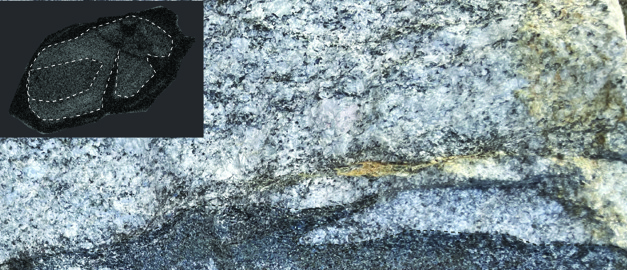
A beautifully zoned zircon with distinct core, rim, and overgrowth, carefully extracted from the leucosome of a diatexite migmatite, recording the magmatic and metamorphic events these rocks have experienced.
Photo: SGU
New data from SGU enhance understanding of critical minerals
The Geological Survey of Sweden (SGU) is conducting several interdisciplinary projects focused on mapping energy-, battery-, and innovation-critical metals and minerals. A new report presents geological data from Västernorrland County that improves knowledge of how Sweden’s bedrock was formed.
SGU’s mapping in Västernorrland County is part of the long-term plan for the period 2021–2027 and includes systematic surveys of metals and minerals critical to energy and technological development. The main objective is to update data and increase knowledge and information related to understanding of the geological, geophysical, and geochemical properties of the bedrock through systematic surveys. The project has a direct impact on society’s transition to green energy, the development of new technologies, and the goals of Agenda 2030.
– The field work observations, data collection, analysis, and interpretation carried out within the project provide new knowledge and information related to understanding the mineral systems and the genesis of mineral deposit, which is very important for future exploration of, among others, lithium, niobium, and tantalum, says Martiya Sadeghi, project manager and senior geologist at SGU.
The results contribute to a more detailed understanding of the geological processes that developed the regional geology. The work also includes age dating of rocks in the southern parts of Västernorrland County. Between 2021 and 2023, samples were collected from several rock types, including granites, granodiorites, migmatites, and felsic volcanic rocks.
The age dating, together with other geological data such as field observations, indicates two magmatic events around 1.94 and 1.88–1.86 billion years ago.
– Age dating in the area also reveals traces of even older geological processes from the Archaean era, which have not been previously documented. Dating of both the migmatites and the felsic volcanic rocks points to previously unknown volcanic activity around 1.98 billion years ago. These new findings provide a more detailed picture of the geological history of the area, says Pauline Jeanneret, senior geologist.
Read the report here:
Insights into Paleoproterozoic magmatic and migmatisation events using U-Pb zircon age dating in Västernorrland, Sweden, SGU-rapport 2025:11
Last reviewed 2025-10-22
